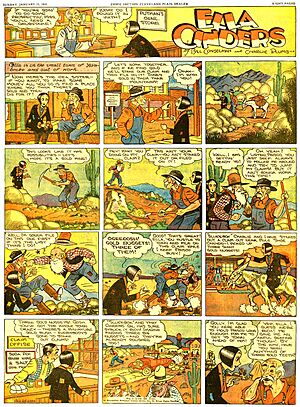Ella Cinders facts for kids
Quick facts for kids Ella Cinders |
|
|---|---|

Bill Conselman and Charles Plumb's Ella Cinders (January 25, 1931). Road signs for Prescott and Wickenburg indicate the setting is in Yavapai County, Arizona. Note the date discrepancy in bottom panels.
|
|
| Author(s) | William Conselman |
| Illustrator(s) | Charles Plumb |
| Current status/schedule | Concluded daily & Sunday strip |
| Launch date | June 1, 1925 |
| End date | December 2, 1961 |
| Syndicate(s) | Metropolitan Newspaper Service (1925–1930) United Feature Syndicate (1930–1961) |
| Genre(s) | Humor |
Ella Cinders was a popular American comic strip. It was created by writer Bill Conselman and artist Charles Plumb. The comic strip was released every day starting June 1, 1925. A Sunday version was added two years later.
Most of its run was handled by United Feature Syndicate. The comic strip ended on December 2, 1961. Another short comic, Chris Crusty, often appeared above Ella Cinders. This happened from July 5, 1931, to July 6, 1941.
Contents
Meet Ella and Her Story
The comic strip Ella Cinders started out like the classic Cinderella fairy tale. Ella was a young woman who looked like a typical 1920s character. She had straight black bobbed hair and big, round eyes. Ella often wore simple clothes, especially in the early comics. She was not shown as super beautiful, unlike many other story characters.
Ella's Family Life
Ella lived with her stepmother, Myrtle "Ma" Cinders. She also had two stepsisters, Prissie and Lotta Pill. Prissie was described as "pinched and acid," meaning she was grumpy and mean. Lotta was "fat and foolish." Both sisters spent their time bothering Ella. They made her do all the housework for Ma Cinders.
To deal with her stepfamily, Ella had some allies. Her brother, Blackie, and her boyfriend, Waite Lifter, helped her. They used jokes and sarcasm to find happiness.
Ella's Big Break
The story changed when Ella got her "fairy godmother" moment. She entered a beauty contest. A judge randomly picked her photo, and she won! The prize was a job at a movie theater. So, Ella and her brother Blackie moved to Hollywood.
When they arrived, they found out the movie studio was closed. But Ella and Blackie decided to stay in Hollywood anyway. Ella kept having fun adventures in the daily comics. The Sunday comics often showed funny, one-time gags. Ella lived a fun life but never became rich. She eventually got married to a man named Patches. He often went on adventures away from home.
Ella Cinders on the Big Screen
A movie based on the comic strip was made in 1926. It was called Ella Cinders. The famous director Alfred E. Green directed it. Colleen Moore starred as Ella Cinders. Her husband, John McCormick, produced the film. First National Pictures released the movie on June 6, 1926.
The Movie's Story
In the film, Ella Cinders (played by Colleen Moore) lives in her late father's house. She works hard for her stepmother and stepsisters, Prissy Pill and Lotta Pill. The local iceman, Waite Lifter, is her friend and supports her.
A film company called Gem Film Company held a contest. The winner would get a free trip to Hollywood and a movie role. To enter, Ella needed a photo. She babysat for three nights to earn $3 for a photo session. But the photographer accidentally took a picture of her looking cross-eyed at a fly on her nose. This funny photo was the one entered in the contest.
Contestants had to go to a ball at Town Hall. Ella's stepmother and stepsisters would not let her go. Waite saw Ella crying outside. He told her he would take her to the ball. Ella said she had nothing to wear. So, Waite convinced her to wear one of her stepsisters' dresses.
At the ball, her stepsisters saw the dress and got very angry. Ella felt embarrassed and ran away, losing one of her slippers. Later, the judges came to Ella's house. They told her she won because they found her cross-eyed photo very amusing.
Ella went to Hollywood, but she was disappointed. The contest was a trick! However, she still managed to get a movie contract. It turned out that Waite was actually a rich football hero named George Waite. Ella and Waite were happily reunited.
Ella Cinders in Books
Ella Cinders also appeared in other types of books. She was featured in the Big Little Books. She also showed up in comic books. These included early issues of Tip Top and Sparkler Comics. Ella even had her own comic book series in 1948–1949.


